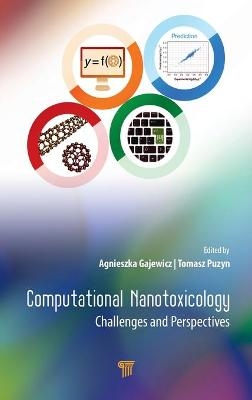
Computational Nanotoxicology
Pan Stanford Publishing Pte Ltd (Verlag)
978-981-4800-64-8 (ISBN)
The development of computational methods that support human health and environmental risk assessment of engineered nanomaterials (ENMs) has attracted great interest because the application of these methods enables us to fill existing experimental data gaps. However, considering the high degree of complexity and multifunctionality of ENMs, computational methods originally developed for regular chemicals cannot always be applied explicitly in nanotoxicology. This book discusses the current state of the art and future needs in the development of computational modeling techniques for nanotoxicology. It focuses on (i) computational chemistry (quantum mechanics, semi-empirical methods, density functional theory, molecular mechanics, molecular dynamics), (ii) nanochemoinformatic methods (quantitative structure–activity relationship modeling, grouping, read-across), and (iii) nanobioinformatic methods (genomics, transcriptomics, proteomics, metabolomics). It reviews methods of calculating molecular descriptors sufficient to characterize the structure of nanoparticles, specifies recent trends in the validation of computational methods, and discusses ways to cope with the uncertainty of predictions. In addition, it highlights the status quo and further challenges in the application of computational methods in regulation (e.g., REACH, OECD) and in industry for product development and optimization and the future directions for increasing acceptance of computational modeling for nanotoxicology.
Agnieszka Gajewicz is assistant professor at the University of Gdansk, Poland. She has authored more than 45 research publications in leading nanotechnology- and environment-related journals and has received prestigious international and national awards, including the L’Oréal-UNESCO International Rising Talents Award For Women in Science and a fellowship of the Polish Minister of Science and Higher Education for outstanding young researchers. Her current research interests include the development and application of machine learning, statistical learning theory, and chemometrics to address problems and challenges in computer-based methods for chemical safety assessment and the design of new chemicals (nanomaterials, ionic liquids) that are safe for human health and the environment. Tomasz Puzyn is professor at the Laboratory of Environmental Chemometrics, Faculty of Chemistry, University of Gdansk, Poland. He has authored more than 120 research papers in leading nanotechnology- and environment-related journals and edited 4 books. His main achievement is the introduction of quantitative structure–activity relationship (QSAR) modeling in nanotechnology. He has led two completed EU FP7 projects and participated in five H2020 projects conducted within the European NanoSafety Cluster. He has received prestigious national and international awards, including fellowships of the Japan Society for the Promotion of Science, the Foundation for Polish Science, and the Polish Minister of Science and Higher Education. Prof. Puzyn is founder and CEO of QSAR Lab Ltd., a spin-off company that uses the potential and experience of research staff from the Laboratory of Environmental Chemometrics to support chemical, cosmetic, and pharmaceutical industries in developing computational methods for designing innovative products (nanomaterials, ionic liquids) that are safe for humans and the environment.
1. Modeling of Nanomaterials for Safety Assessment: From Regulatory Requirements to Supporting Scientific Theories 2. Current Developments and Recommendations in Computational Nanotoxicology in View of Regulatory Application 3. Physicochemical Properties of Nanomaterials from in silico simulations: An Introduction to Density Functional Theory and Beyond 4. Bionano Interactions: A Key to a Mechanistic Understanding of Nanoparticle Toxicity 5. From Modeling Nanoparticle–Membrane Interactions toward Nanotoxicology 6. Descriptors in Nano-QSAR/Nano-QSPR Modeling 7. Nano-QSAR for Environmental Hazard Assessment: Turning Challenges into Opportunities 8. Read-Across to Fill Toxicological Data Gaps: Good Practice to Ensure Success with Nanoparticles 9. Computational Methods of Interspecies Nanotoxicity Extrapolation: A Step toward the Future 10. On Error Measures for Validation and Uncertainty Estimation of Predictive QSAR Models 11. Green Toxicology Meets Nanotoxicology: The Process of Sustainable Nanomaterial Development and Use 12. Issues for and Examples of Computational Design of “Safe-by-Design” Nanomaterials
| Erscheinungsdatum | 24.12.2019 |
|---|---|
| Zusatzinfo | 43 Tables, black and white; 1 Line drawings, black and white; 51 Halftones, color; 5 Halftones, black and white; 51 Illustrations, color; 6 Illustrations, black and white |
| Verlagsort | Singapore |
| Sprache | englisch |
| Maße | 152 x 229 mm |
| Gewicht | 1000 g |
| Themenwelt | Naturwissenschaften ► Biologie |
| Naturwissenschaften ► Chemie ► Physikalische Chemie | |
| Sozialwissenschaften ► Pädagogik | |
| Technik ► Umwelttechnik / Biotechnologie | |
| ISBN-10 | 981-4800-64-3 / 9814800643 |
| ISBN-13 | 978-981-4800-64-8 / 9789814800648 |
| Zustand | Neuware |
| Haben Sie eine Frage zum Produkt? |
aus dem Bereich


